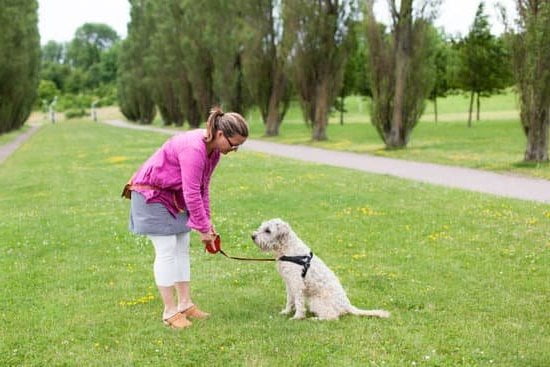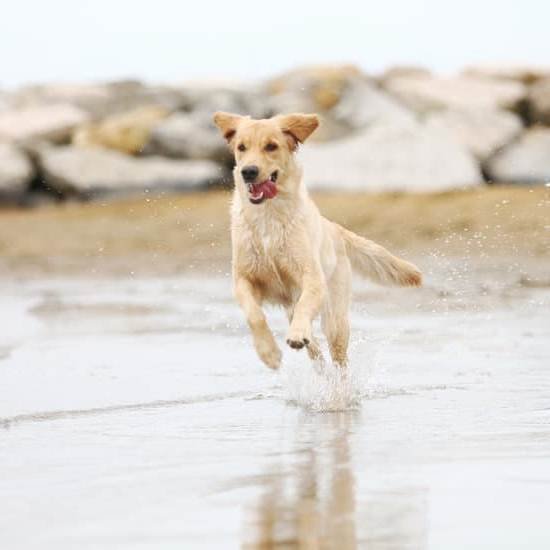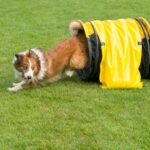House training a blind dog requires a unique approach and understanding of the challenges that come with their disability. In this article, we will explore the specific needs of blind dogs and provide practical guidance on how to effectively house train them. From creating a safe environment to using scent and sound to aid in training, we will cover all aspects of caring for and training a visually impaired canine companion.
Understanding a blind dog’s needs is crucial when it comes to successful house training. It’s important to create an environment that is both safe and familiar for them, utilizing scent and sound cues to aid in their training. Establishing a routine and using verbal and tactile cues for commands are essential components of their training plan. Additionally, positive reinforcement methods are highly effective in helping blind dogs adjust to their new surroundings.
Throughout this article, we will delve into various strategies and helpful resources available for those who are navigating the unique challenges of house training a blind dog. From addressing potential challenges to celebrating progress, this comprehensive guide aims to offer support and guidance for pet owners who want to ensure that their visually impaired furry friend feels comfortable in their home.
Creating a Safe and Familiar Environment
Removing Potential Hazards
When creating a safe environment for your blind dog, it’s important to remove any potential hazards that could cause injury. This includes ensuring that there are no sharp objects or obstacles in their path, securing loose cords or cables, and using baby gates to block off stairs or other dangerous areas.
Establishing Consistent Layout
Blind dogs navigate their surroundings based on memory and familiarity. To help them feel more secure in their environment, consider keeping furniture and other items in the same place to create a consistent layout. You can also use scented markers or essential oils in different rooms to help your blind dog identify specific areas of the house.
Providing a Comfortable Rest Area
A comfortable rest area is essential for a blind dog, especially during the house training process. Choose a quiet and easily accessible spot where they can rest undisturbed. Consider using bedding with familiar scents to provide them with comfort and security as they adjust to their new surroundings.
By creating a safe and familiar environment for your blind dog, you can help ease their transition into house training and set the stage for successful training sessions. Understanding how to accommodate their specific needs is key in helping them thrive in their home environment.
Using Scent and Sound to Aid Training
Training a blind dog to navigate and use the bathroom in your home can present some unique challenges, but with patience and the right techniques, it is definitely achievable. Using scent and sound to aid in training is an essential part of house training a blind dog.
One effective method for house training a blind dog is to use scented markers to delineate important areas in your home. For example, you can use different scents (such as citrus or lavender) to mark the entrance to the house, the door leading outside, and specific spots where you want your dog to relieve themselves.
This will help your blind dog establish mental maps of your home based on smell, making it easier for them to understand where they should go.
In addition to using scent markers, incorporating sound cues can also be helpful. You can use consistent verbal cues or clicker sounds to signal when it’s time for your dog to go outside or when they have successfully gone in an appropriate spot.
By pairing these auditory cues with other sensory information, such as scent markers and tactile sensations from their surroundings, you can provide your blind dog with a multi-sensory experience that aids them in learning how to navigate and behave within your home.
Overall, using scent and sound cues tailored specifically for a blind dog’s needs is an excellent way to support their house training process. With patience, consistency, and the right tools, you can effectively communicate with your blind dog and help them thrive in their new environment.
| Method | Description |
|---|---|
| Scent Markers | Using scents like citrus or lavender to mark important areas in the home |
| Sound Cues | Using consistent verbal cues or clicker sounds for signaling behavior |
Establishing a Routine for House Training
Creating a routine is essential when house training a blind dog. Without the ability to rely on visual cues, your dog will need consistency in their daily schedule to feel secure and confident in their environment. Here are some steps on how to establish a routine for house training a blind dog:
Consistent Feeding and Potty Break Schedule
One of the first steps in establishing a routine is to create a consistent feeding schedule for your blind dog. By feeding them at the same times each day, you can predict when they will need to go outside for potty breaks. It’s important to take them out for bathroom breaks immediately after eating, waking up, or engaging in playtime.
Designated Bathroom Area
Creating a specific area where your blind dog can relieve themselves will help them understand where they should go potty. Use scent markers such as training sprays or specific materials (like mulch or grass) in this area to provide olfactory cues that it’s an appropriate spot for elimination.
Regular Outdoor Time
Take your blind dog outside frequently throughout the day, even if they don’t indicate that they need to go potty. This regular outdoor time helps them become familiar with their surroundings and reinforces the routine of going outside for bathroom breaks.
By following these strategies and maintaining a consistent routine, you can help your blind dog feel more secure and confident during the house training process. Remember that patience and positive reinforcement are key components in successfully house training a blind dog.
Using Verbal and Tactile Cues for Commands
Blind dogs rely heavily on verbal and tactile cues for commands, as opposed to visual cues. When it comes to house training a blind dog, using these alternative methods is crucial for their success. Here are some tips on how to effectively use verbal and tactile cues for commands when training a blind dog:
- Verbal Cues: Utilize clear and consistent verbal cues when giving commands such as “sit,” “stay,” or “come.” Use a calm and reassuring tone of voice, and be sure to say the command before gently guiding your dog into the desired position.
- Tactile Cues: Incorporate tactile cues such as gentle touches, pats, or leash nudges to help guide your blind dog during training. For example, gently press down on your dog’s back end when saying “sit,” or gently pull the leash towards you when saying “come.”
It’s important to remember that each blind dog may respond differently to various cues, so it’s essential to be patient and observant throughout the training process. Additionally, consistency is key when using verbal and tactile cues for commands – make sure that every member of the household is using the same cues to avoid confusion for your blind dog.
Ultimately, establishing a strong bond with your blind dog through effective communication methods will greatly contribute to their success in house training. By utilizing clear and consistent verbal and tactile cues, you can help your blind dog feel more secure and confident in their environment.
To enhance the effectiveness of these cues in training your blind dog, consider working with a professional trainer who has experience in training dogs with visual impairments. They can provide valuable guidance and resources tailored specifically to the needs of blind dogs.
Implementing Positive Reinforcement Methods
Blind dogs, like all dogs, respond well to positive reinforcement during training. Positive reinforcement involves rewarding your dog for good behavior rather than punishing them for mistakes. This method is especially important for blind dogs, as it helps build their confidence and trust in their environment. When house training a blind dog, positive reinforcement can be used to encourage them to go to the bathroom in the appropriate place and to follow other commands.
One effective positive reinforcement method is clicker training. Clicker training involves using a small device that makes a clicking sound to indicate when the dog has done something correctly. This method can be particularly helpful for blind dogs, as it provides a clear and consistent signal of good behavior. In addition to clicker training, using treats or verbal praise as rewards can also be effective ways of reinforcing positive behaviors in blind dogs.
It’s important to remember that house training a blind dog may take longer than with sighted dogs, so patience is key. Consistency in using positive reinforcement methods and maintaining a regular routine will help your blind dog learn where they should go to the bathroom and other important behaviors. By implementing these methods with patience and consistency, you can effectively house train a blind dog and create a happy and healthy environment for both you and your pet.
| Positive Reinforcement Methods | Benefits |
|---|---|
| Clicker training | Provides clear and consistent signal of good behavior |
| Treats or verbal praise | Effective ways of reinforcing positive behaviors |
Addressing Challenges and Adjusting Strategies
Blind dogs may face unique challenges when it comes to house training, but with the right strategies and adjustments, they can still learn to do their business in the appropriate place. Here are some tips for addressing challenges and adjusting strategies:
1. Understanding Your Blind Dog’s Signals: Since blind dogs cannot rely on visual cues, they may use different signals to indicate that they need to go outside. It’s important for pet owners to understand their dog’s behavior and body language. Some blind dogs may pace or sniff around more when they need to go potty, while others may whine or bark at the door.
2. Adapting the Training Area: For blind dogs, having a consistent and easily accessible potty area is crucial. Make sure that the designated spot for elimination is free from obstacles and distractions. You can use scent markers such as specific plants or soil to help your blind dog locate the potty area more easily.
3. Utilizing Touch and Sound Cues: In addition to using verbal cues for commands, consider incorporating tactile stimuli like a specific texture of flooring or special mat for the potty area. You can also use sound cues such as a specific bell or chime near the door so that your blind dog can associate the sound with going outside.
By understanding your blind dog’s needs and making adjustments to your training methods, you can effectively house train them in a way that caters to their sensory abilities. It will require patience and consistency, but with time and effort, you can successfully teach your blind dog how to handle their toileting needs appropriately within your home environment”.
Seeking Professional Help and Resources for Blind Dog Training
Training a blind dog can present unique challenges, but with the right support and resources, it is possible to successfully house train them. One of the first steps in seeking professional help is to consult a veterinarian who has experience working with visually impaired dogs.
They can provide valuable insights into any medical conditions that may be affecting your dog’s ability to be house trained, as well as offer guidance on how to effectively communicate with and train a blind dog.
In addition to veterinary support, there are also professional dog trainers who specialize in working with visually impaired dogs. These trainers can create personalized training plans that take into account the specific needs of your blind dog, and offer invaluable guidance on how to house train a blind dog using positive reinforcement methods.
They can teach you how to use scent and sound cues effectively, establish routines that cater to your dog’s needs, and troubleshoot any challenges that may arise during the training process.
Furthermore, there are numerous resources available online and in print that provide valuable information and support for training a blind dog. These resources can include step-by-step guides on how to introduce tactile cues for commands, tips for creating a safe environment for your blind dog, and strategies for addressing common challenges in house training.
By utilizing these resources in conjunction with professional help, you can equip yourself with the knowledge and tools needed to successfully train your blind dog.
Celebrating Progress and Patience in the Training Process
House training a blind dog requires patience, understanding, and dedication. It may take longer than training a sighted dog, but with the right techniques and consistent training, it is possible to successfully house train a blind dog. Celebrating the progress made throughout the training process is essential in keeping both the dog and the owner motivated.
One of the key components to house training a blind dog is establishing a routine. Consistency in feeding times, potty breaks, and exercise can help the dog understand what is expected of them. Using scent markers or sound cues can aid in creating a familiar environment for the blind dog, allowing them to navigate their surroundings more confidently.
Utilizing positive reinforcement methods such as treats, praise, and affection is crucial in encouraging desired behavior. Additionally, seeking professional help and resources for blind dog training can provide valuable guidance and support.
It’s important to remain patient and celebrate even small victories as progress is made in the house training journey with a blind dog. By following these methods and staying positive throughout the process, owners can effectively house train their blind dogs while strengthening their bond through patience and persistence.
Frequently Asked Questions
Can Blind Dogs Be Trained?
Blind dogs can absolutely be trained. They rely heavily on their other senses, such as hearing and smell, to navigate the world around them. With patience, consistency, and positive reinforcement, blind dogs can learn commands and routines just like sighted dogs.
How Do You Train an Older Blind Dog?
Training an older blind dog requires a gentle and patient approach. It’s important to use verbal cues and touch to communicate with the dog, as well as creating a safe and consistent environment. Introducing new commands slowly and using treats as rewards can also help in training an older blind dog.
How Long Does It Take a Blind Dog to Adjust?
The time it takes for a blind dog to adjust to their condition varies from dog to dog. Some dogs may adapt quickly within a few weeks, while others may take longer. Patience, love, and providing a stable routine can greatly help in the adjustment process for a blind dog.

Welcome to the blog! I am a professional dog trainer and have been working with dogs for many years. In this blog, I will be discussing various topics related to dog training, including tips, tricks, and advice. I hope you find this information helpful and informative. Thanks for reading!





